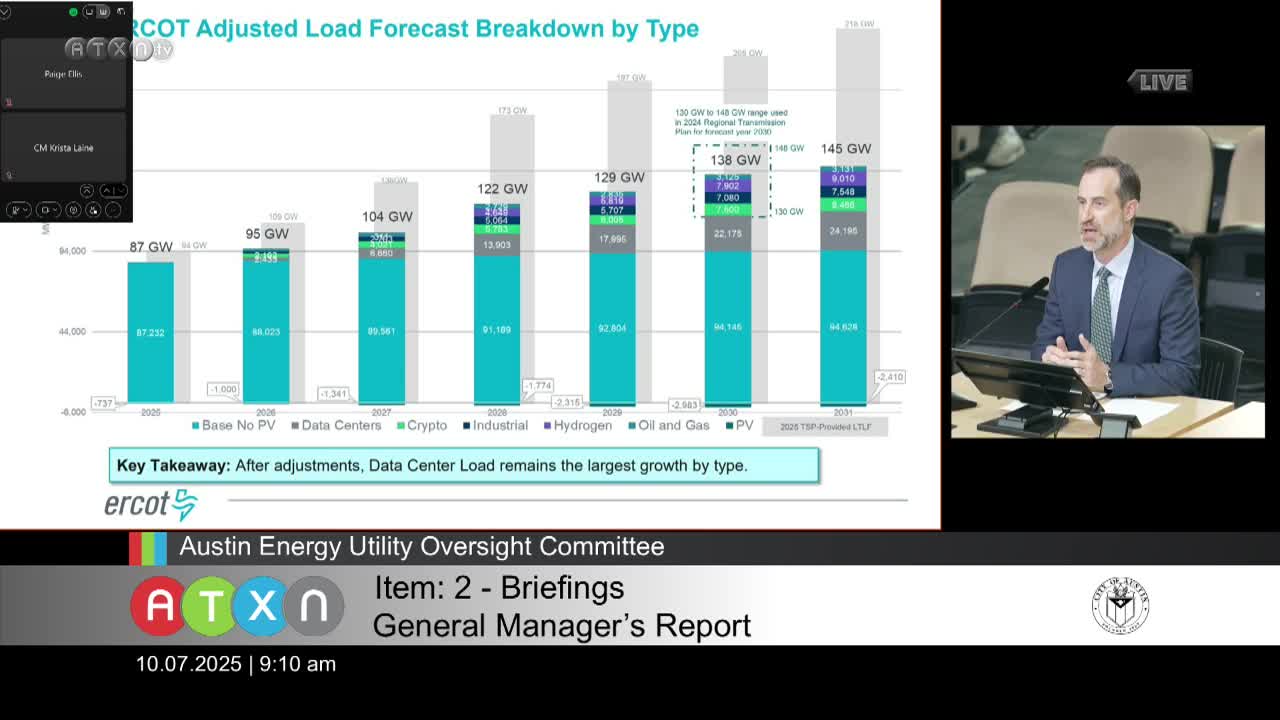ERCOT forecasts 67% demand increase due to data centers and industrial growth
October 07, 2025 | Austin, Travis County, Texas
This article was created by AI summarizing key points discussed. AI makes mistakes, so for full details and context, please refer to the video of the full meeting. Please report any errors so we can fix them. Report an error »

In a recent meeting of the Austin Energy Utility Oversight Committee, city officials and energy experts gathered to discuss the pressing challenges facing the electric grid as demand surges. The atmosphere was charged with urgency as they examined the implications of a forecasted 67% increase in ERCOT demand over the next six years, a growth equivalent to adding more than 19 Austins to the energy mix.
As the discussion unfolded, it became clear that the rapid rise in demand is driven by large-scale customers, including data centers and industrial operations, eager to connect to Austin's energy system. However, this influx presents significant hurdles. The committee highlighted the difficulty in distinguishing between potential customers that will materialize and those that may not, complicating load forecasts and planning.
A key concern raised was the capacity of the existing grid infrastructure. Many areas are not equipped to handle such large loads, leading to a pressing need for investment in new infrastructure. Yet, the committee noted that equipment shortages are exacerbating the situation. Essential components like substation transformers and circuit breakers face long lead times due to limited manufacturers, creating a bottleneck in the ability to meet customer demands.
The urgency of these requests from large customers contrasts sharply with the lengthy regulatory and construction processes, which can take up to five years. This mismatch poses a risk for utilities, as they must ensure that investments in infrastructure do not lead to stranded costs—expenses incurred without the anticipated return from new customers.
Austin's approach to managing growth, where new customers pay for their line extensions, was discussed as a potential model for mitigating these risks. However, the committee acknowledged that ensuring the financial viability of grid-scale investments remains a challenge.
As the meeting concluded, the committee members reflected on the broader implications of these developments. The increasing demand for energy not only threatens to strain local resources but also contributes to rising prices in the market. With the city's commitment to the Resource Generation and Climate Protection Plan aimed at addressing these issues by 2035, the path forward remains critical for both Austin and the wider ERCOT region. The discussions underscored the need for strategic planning and collaboration to navigate the complexities of a rapidly evolving energy landscape.
As the discussion unfolded, it became clear that the rapid rise in demand is driven by large-scale customers, including data centers and industrial operations, eager to connect to Austin's energy system. However, this influx presents significant hurdles. The committee highlighted the difficulty in distinguishing between potential customers that will materialize and those that may not, complicating load forecasts and planning.
A key concern raised was the capacity of the existing grid infrastructure. Many areas are not equipped to handle such large loads, leading to a pressing need for investment in new infrastructure. Yet, the committee noted that equipment shortages are exacerbating the situation. Essential components like substation transformers and circuit breakers face long lead times due to limited manufacturers, creating a bottleneck in the ability to meet customer demands.
The urgency of these requests from large customers contrasts sharply with the lengthy regulatory and construction processes, which can take up to five years. This mismatch poses a risk for utilities, as they must ensure that investments in infrastructure do not lead to stranded costs—expenses incurred without the anticipated return from new customers.
Austin's approach to managing growth, where new customers pay for their line extensions, was discussed as a potential model for mitigating these risks. However, the committee acknowledged that ensuring the financial viability of grid-scale investments remains a challenge.
As the meeting concluded, the committee members reflected on the broader implications of these developments. The increasing demand for energy not only threatens to strain local resources but also contributes to rising prices in the market. With the city's commitment to the Resource Generation and Climate Protection Plan aimed at addressing these issues by 2035, the path forward remains critical for both Austin and the wider ERCOT region. The discussions underscored the need for strategic planning and collaboration to navigate the complexities of a rapidly evolving energy landscape.
View full meeting
This article is based on a recent meeting—watch the full video and explore the complete transcript for deeper insights into the discussion.
View full meeting
